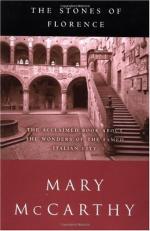
|
| Name: _________________________ | Period: ___________________ |
This test consists of 15 multiple choice questions and 5 short answer questions.
Multiple Choice Questions
1. Which artist does the author NOT mention as depicting objects from ordinary life, such as household utensils?
(a) Fra Fillipo.
(b) Ghirlandaio.
(c) Gozzoli.
(d) Leonardo.
2. What church replaced the Santa Reparata?
(a) The Duomo.
(b) Santissima Annunziata.
(c) Santa Trinita.
(d) Santa Croce.
3. According to the author in Chapter 4, what artistic idea did the Venetians learn from the Florentines?
(a) Perspective.
(b) Cubism.
(c) Impressionism.
(d) Trompe l'oeil.
4. According to Chapter 4, what was the first major literary work written in Italian?
(a) Faustus.
(b) The Divine Comedy.
(c) Bella Divina.
(d) Daniel DeFoe.
5. What word did Brunelleschi use to describe the figure of Christ on Donatello's crucifix for Santa Croce?
(a) "King."
(b) "Self-portrait."
(c) "Idiot."
(d) "Clown."
6. Who wrote the instructional booklet Della Pittura?
(a) Leon Battista Alberti.
(b) Brunelleschi.
(c) Paolo Uccello.
(d) Toscanelli.
7. What was the nickname for people who followed Savonarola?
(a) Mascarpone.
(b) Piagnone.
(c) Pietone.
(d) Corleone.
8. According to Chapter 6, what are the two extreme images in Florentine painting?
(a) The Crucifixion and the Resurrection.
(b) The Flood and the Resurrection.
(c) The Fall and the Nativity.
(d) The Crucifixion and the Annunciation.
9. Where was "The Battle of San Romano" originally housed?
(a) The chambers of Pope Clement VII.
(b) The bedroom of Lorenzo de' Medici.
(c) The Uffizi.
(d) The Boboli Garden.
10. To what character in Greek mythology does the author compare the "Madonna with the Pomegranate"?
(a) Persephone.
(b) Athena.
(c) Penelope.
(d) Psyche.
11. On what holiday do Florentine vendors sell crickets?
(a) May Day.
(b) The Feast of the Annunciation.
(c) Michaelmas.
(d) Ascension Day.
12. As mentioned in Chapter 4, which artist enjoyed witnessing hangings?
(a) Leonardo.
(b) Michelangelo.
(c) Fra Fillipo Lippi.
(d) Brunelleschi.
13. Which Florentine does the author describe as a "zoophile"?
(a) Brunelleschi.
(b) Donatello.
(c) Ammannati.
(d) Uccello.
14. As mentioned in Chapter 5, which artists did the Romans think were searching for treasure around the ruins of ancient structures?
(a) Leonardo and Donatello.
(b) Fra Fillipo Lippi and Uccello.
(c) Uccello and Andrea del Castagno.
(d) Brunelleschi and Donatello.
15. Whom does the author call "the resident humanist in the Medici household"?
(a) Catherine the Great.
(b) Poliziano.
(c) Michelangelo.
(d) Clarice Orsini.
Short Answer Questions
1. Who wrote the poem "Ode to the West Wind"?
2. As mentioned in Chapter 5, what did Donatello and Brunelleschi plan to have for lunch one day?
3. In what work does Milton mention Florence three times?
4. Whom does the author describe in Chapter 6 as a "tame, cruel housemouser"?
5. When did the Spanish military overthrow the Florentine Republic?
|
This section contains 391 words (approx. 2 pages at 300 words per page) |

|




